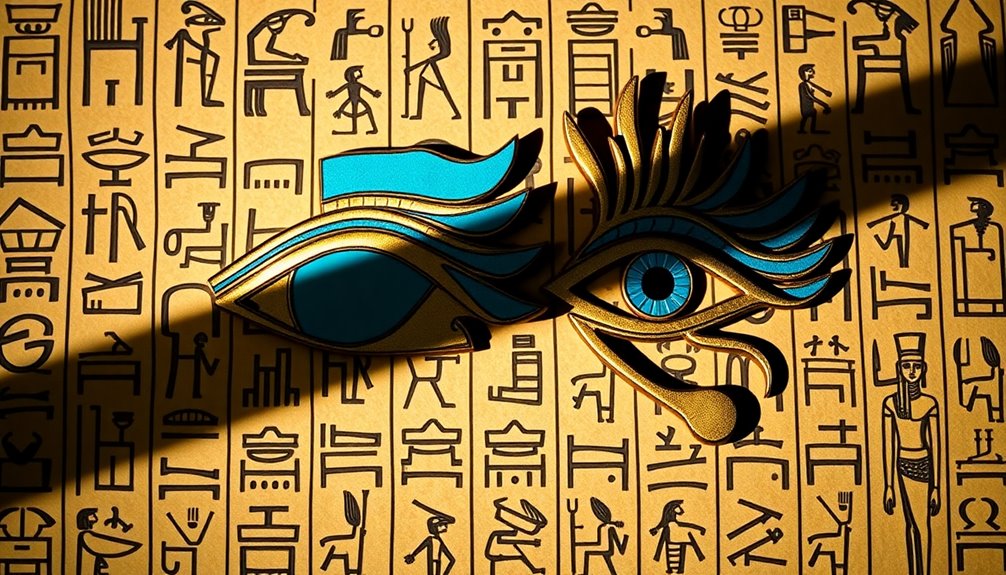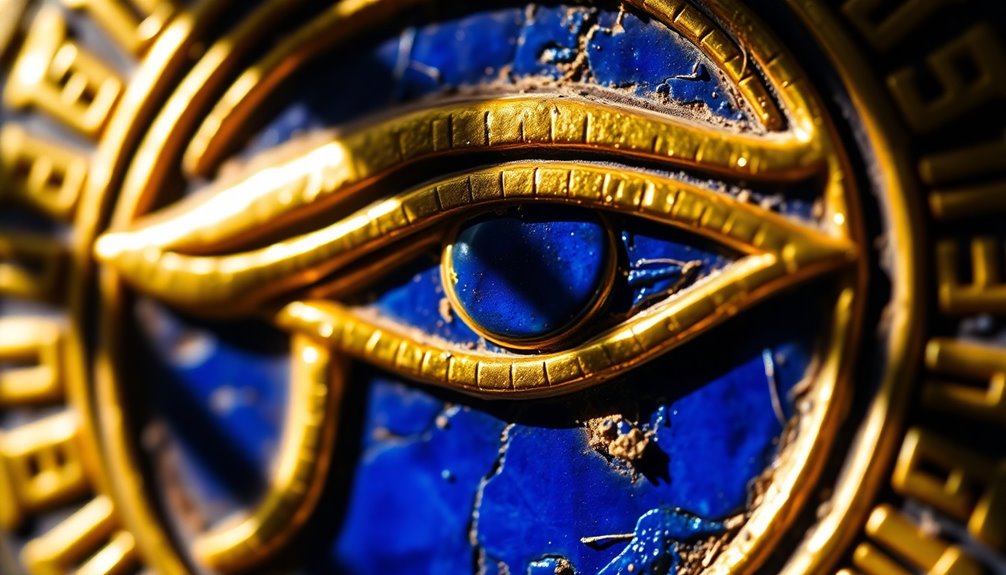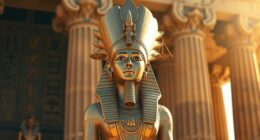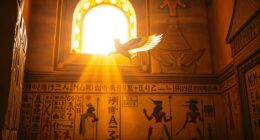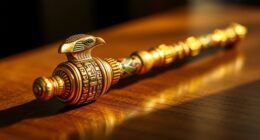You've probably noticed the buzz around the Eye of Ra and Eye of Horus lately. This surge stems from their rich symbolism and modern appeal. The Eye of Horus represents healing and protection, while the Eye of Ra embodies power and authority. Both symbols are appearing in fashion and art, often endorsed by celebrities. As people seek deeper connections to ancient cultures, these symbols have become trendy icons of strength and wisdom. Understanding their historical significance adds layers to their allure. Stick around, and you'll uncover even more fascinating insights about these enchanting emblems.
Key Takeaways
- The Eye of Ra symbolizes power and destruction, while the Eye of Horus represents healing and protection, showcasing contrasting ancient beliefs.
- Recent celebrity endorsements and fashion trends have popularized these symbols, leading to increased public interest and visibility.
- Both symbols are featured in modern jewelry and tattoos, merging ancient symbolism with contemporary aesthetics.
- Conversations around cultural appropriation have emerged, emphasizing the need for ethical representation and understanding of these symbols' historical significance.
- The resurgence in interest drives scholarly research and cultural discussions, promoting awareness of ancient Egyptian heritage and its impact on today's society.
Cultural Significance of the Eyes
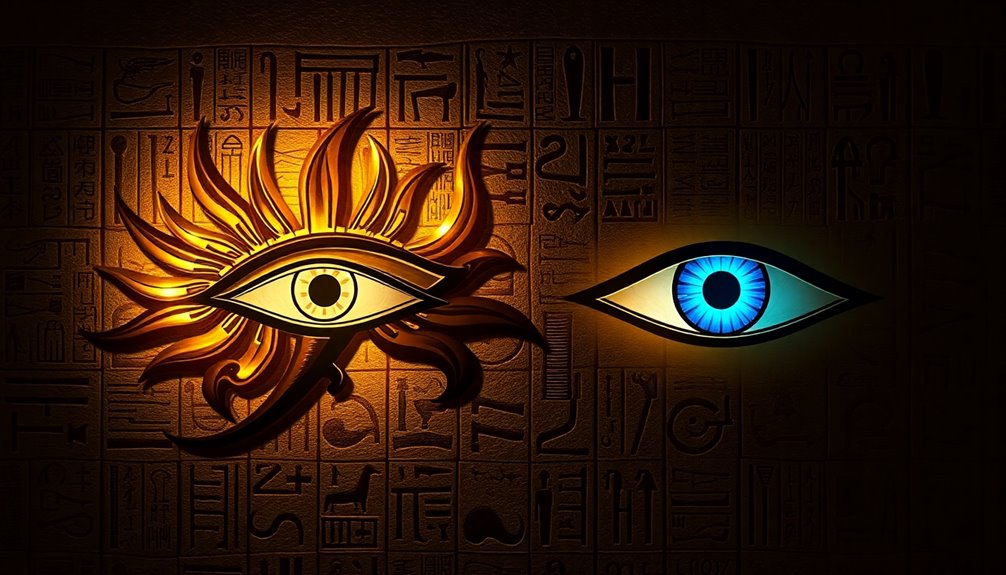
The Eyes of Ra and Horus hold profound cultural significance in ancient Egyptian society. These symbols in Egyptian culture were more than just artistic expressions; they embodied deep spiritual meanings.
The Eye of Horus, or wedjat, symbolized healing and protection. You'd often find it on amulets, safeguarding individuals from harm. In contrast, the Eye of Ra represented power and destruction, serving as a protective emblem against enemies and negative forces.
Both eyes were integral to ancient Egyptian rituals and beliefs about life, death, and the afterlife. The Eye of Horus, linked to the myth of Horus avenging Osiris, conveyed themes of restoration and wholeness.
Meanwhile, the Eye of Ra, associated with the sun god Ra, symbolized divine authority and the cycle of life.
Historically, the Eye of Horus was tied to health, its six parts corresponding to the senses, while the Eye of Ra was invoked in solar worship and royal regalia.
Today, both symbols resonate in contemporary culture, with the Eye of Horus representing protection and good fortune, and the Eye of Ra signifying strength and power in modern art and design.
Eye of Horus: Myth and Meaning
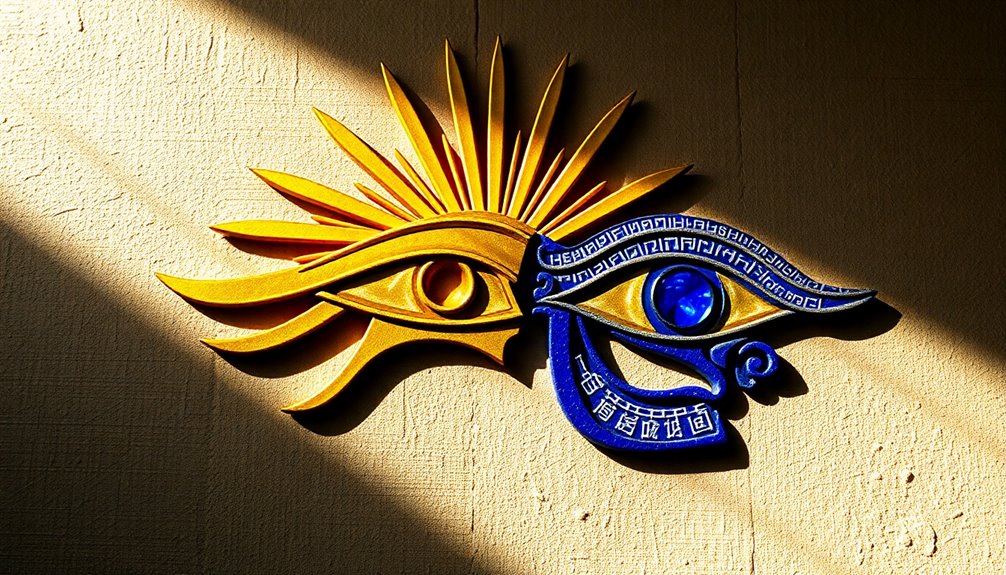
Symbolizing healing and protection, the Eye of Horus, or Wedjat, carries rich mythological significance in ancient Egyptian culture. This powerful symbol embodies the resilience of Horus, who lost his eye in a fierce battle against Set. The eye's restoration by the god Thoth underscores themes of regeneration and wholeness.
When you think of the Eye of Horus, imagine:
- A falcon's gaze, sharp and vigilant.
- An amulet, worn close to the heart, warding off malevolent forces.
- The phases of the moon, representing the cycle of life and renewal.
- The intricate markings, signifying the connection between the physical and spiritual domains.
In ancient Egyptian mythology, the Eye of Horus isn't just an emblem; it's a potent symbol of protection and healing. The eye's six parts correlate to the senses, totaling a numerical value of 63/64, with the missing 1/64 symbolizing imperfection and the ongoing journey of healing.
Eye of Ra: Myth and Meaning
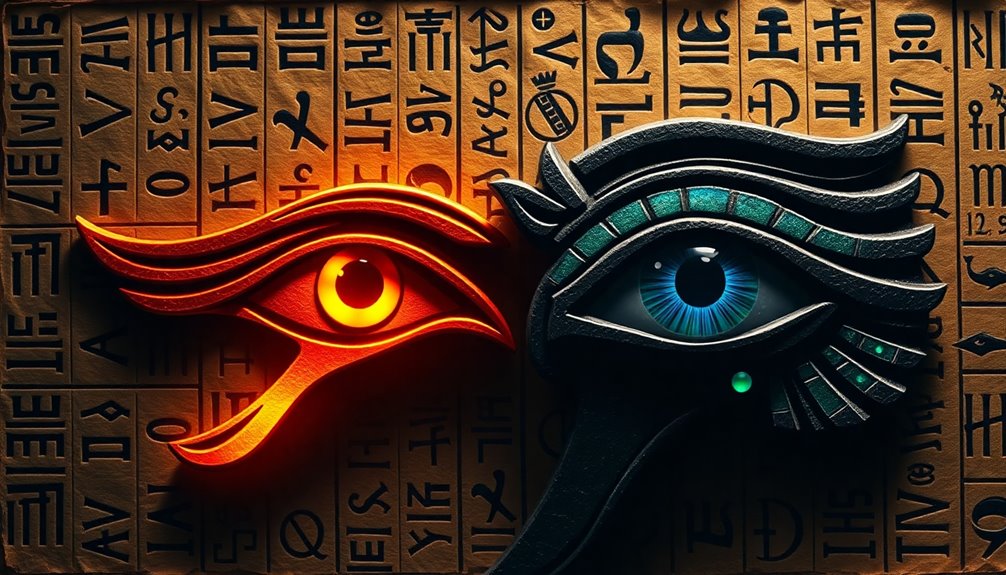
With its fierce gaze, the Eye of Ra stands as a powerful emblem in ancient Egyptian mythology, representing the sun god Ra's authority and might. Unlike the Eye of Horus, which embodies healing, the Eye of Ra captures the sun's destructive power, serving as a weapon against those who provoke Ra's anger. In mythology, it was created by Hathor, reflecting its role as a vengeful force, punishing humanity when needed.
The Eye of Ra isn't just about wrath; it also functions as a protective symbol, often associated with the uraeus, a cobra that signifies divine authority. This connection highlights its importance in safeguarding the pharaohs, who were seen as the earthly representation of Ra.
The Eye of Ra acts as a vigilant guardian, monitoring the domain and ensuring justice is maintained, thereby contributing to the cosmic order.
This intricate balance of power and protection reveals the duality of Ra's influence, where the Eye of Ra stands not only as a punishing force but also as a symbol of divine oversight in the ancient Egyptian worldview. Understanding this complexity deepens your appreciation for the rich tapestry of Egyptian mythology.
Key Differences Between the Eyes
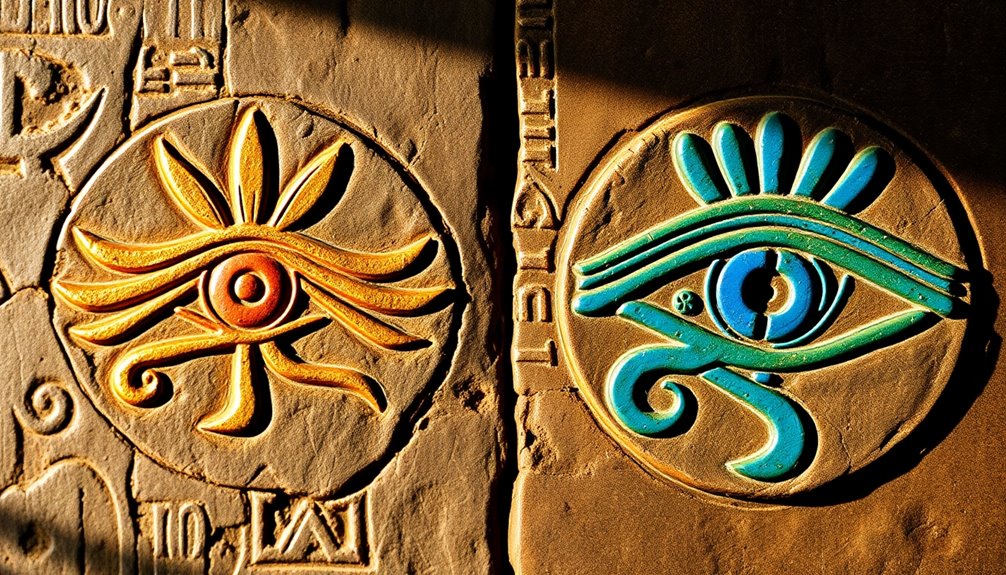
When comparing the Eye of Ra and the Eye of Horus, you'll quickly notice key distinctions that highlight their unique roles in ancient Egyptian mythology. Here are four vital differences:
- Symbolic Representation: The Eye of Ra, associated with the sun god Ra, symbolizes power and authority, while the Eye of Horus, linked to the god Horus, represents healing and protection.
- Creation and Purpose: The Eye of Ra was created as a weapon for vengeance against humanity, whereas the Eye of Horus lost its eye in a battle against Set and was restored by Thoth, symbolizing recovery.
- Visual Elements: The Eye of Ra often features a cobra or sun disk, whereas the Eye of Horus showcases distinctive falcon-like markings, commonly used in funerary contexts.
- Cultural Significance: Though often confused, the Eye of Ra embodies active power and punishment, while the Eye of Horus signifies wholeness and wisdom, reflecting their distinct meanings in ancient Egyptian civilization.
Understanding these differences enhances your appreciation for the rich symbolism embedded in these powerful icons.
Symbolism in Ancient Egyptian Art
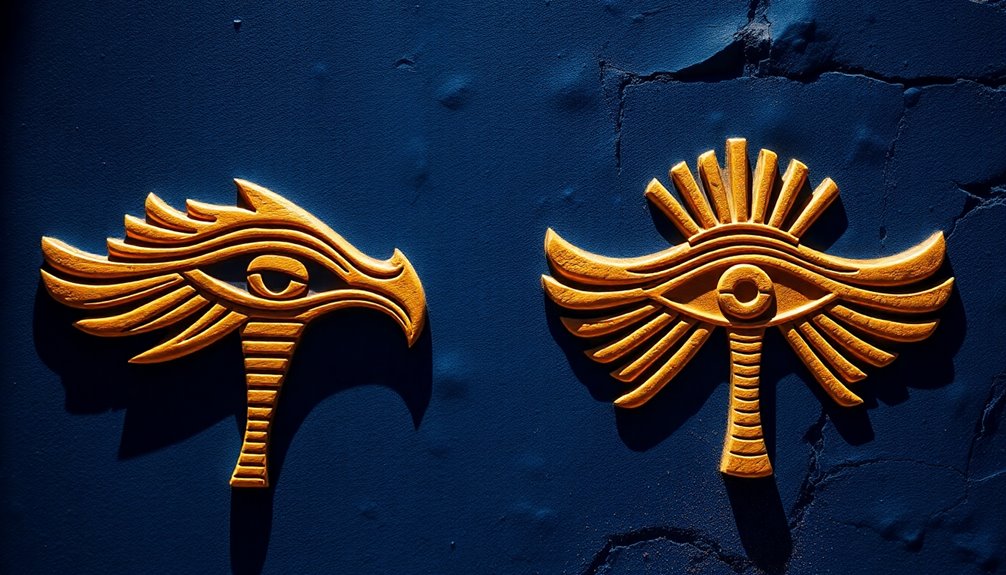
In ancient Egyptian art, powerful symbols like the Eye of Ra and the Eye of Horus play essential roles in conveying deeper meanings and cultural beliefs. The Eye of Ra, often depicted as a sun disk surrounded by a serpent or as a lioness, represents the sun's power and protective qualities.
In contrast, the Eye of Horus, marked with falcon-like features, symbolizes healing, protection, and royal power. You'll notice that these eyes frequently appear together in ancient Egyptian art, emphasizing their duality. The Eye of Horus embodies the moon and healing, while the Eye of Ra signifies the sun and destructive power.
This duality showcases the balance between creation and destruction, a core concept in ancient Egyptian spirituality. Amulets featuring the Eye of Horus were commonly used in funerary contexts, designed to protect the deceased and guarantee safe passage to the afterlife.
Meanwhile, the Eye of Ra found its place in temples, invoking the sun god's authority. Together, they represent themes of protection and power, woven intricately into the fabric of ancient Egyptian art through jewelry and sculptures, reminding us of their enduring significance.
Modern Interpretations and Relevance
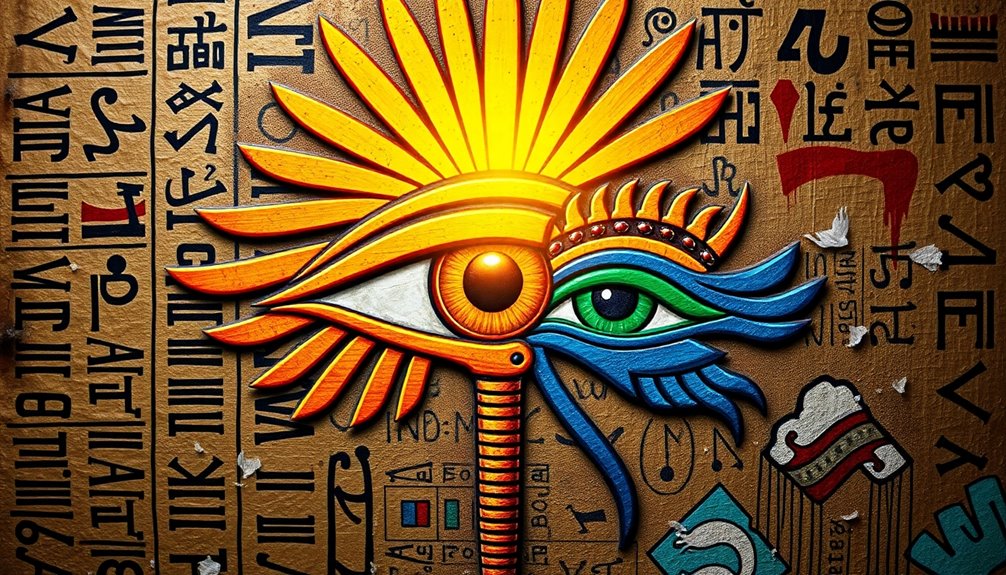
Resurgence in interest surrounding ancient Egyptian symbols like the Eye of Ra and the Eye of Horus illustrates their enduring appeal in modern culture.
These symbols have become popular icons of protection and power, showcasing how ancient meanings adapt to contemporary themes.
You might find them represented as:
- Stylish jewelry that amplifies your outfit while embodying strength.
- Fashion statements worn by celebrities like Kim Kardashian and Gigi Hadid, merging history with modern trends.
- Tattoo designs that serve as personal talismans of healing and authority.
- Artistic prints that honor their cultural origins while making them accessible to a wider audience.
In the Eye of Ra vs Eye of Horus debate, modern interpretations often simplify their intricate designs, making them visually appealing but sometimes overlooking their deeper meanings.
The Eye of Horus embodies healing and protection, while the Eye of Ra symbolizes strength and authority.
As these symbols weave into various forms of art and design, there's a growing awareness of the importance of respecting their historical significance, ensuring that the allure of ancient Egyptian culture continues to resonate today.
Spiritual Connections and Beliefs
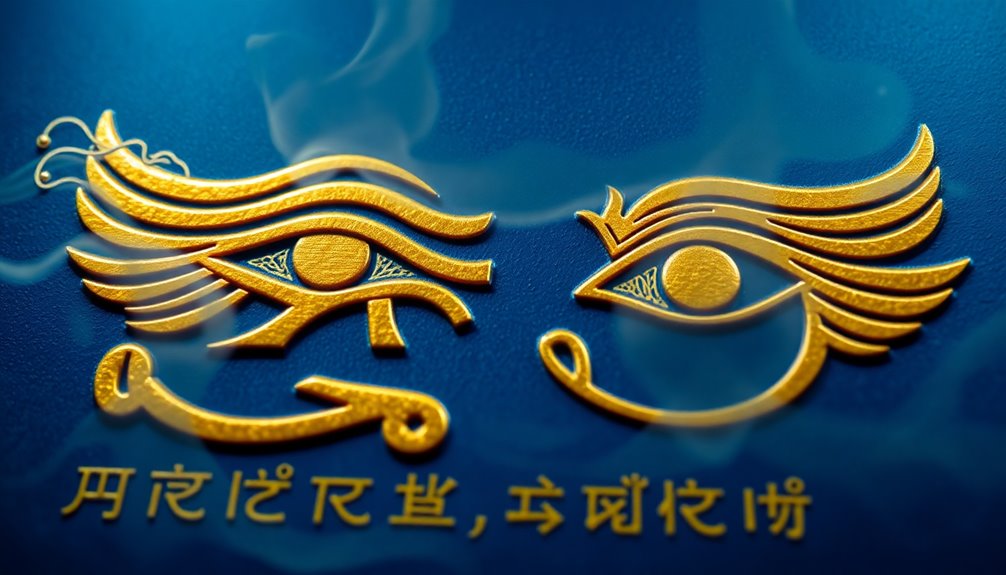
The Eye of Horus and the Eye of Ra carry profound spiritual significance that extends far beyond their aesthetic appeal. In Egyptian belief, the Eye of Horus symbolizes healing, protection, and wholeness, often associated with the restorative power of the moon. It reflects a narrative of Horus avenging his father, Osiris, emphasizing themes of justice and safety in the afterlife.
On the other hand, the Eye of Ra, representing power and destruction, embodies the fierce strength of the sun god Ra. This ancient symbol is called upon for protection against enemies and punishing those who defy divine authority.
Both symbols played vital roles in spiritual practices, frequently appearing in amulets designed to provide protection and guarantee well-being for the wearer. The Eye of Horus is often invoked for health, while the Eye of Ra secures strength and dominance.
Their contrasting attributes continue to resonate with those seeking spiritual connections today. As you explore these ancient symbols, you'll find that both the Eye of Horus and the Eye of Ra offer rich insights into the values and beliefs of ancient Egyptian spirituality, showcasing their enduring legacy.
Popularity in Contemporary Culture
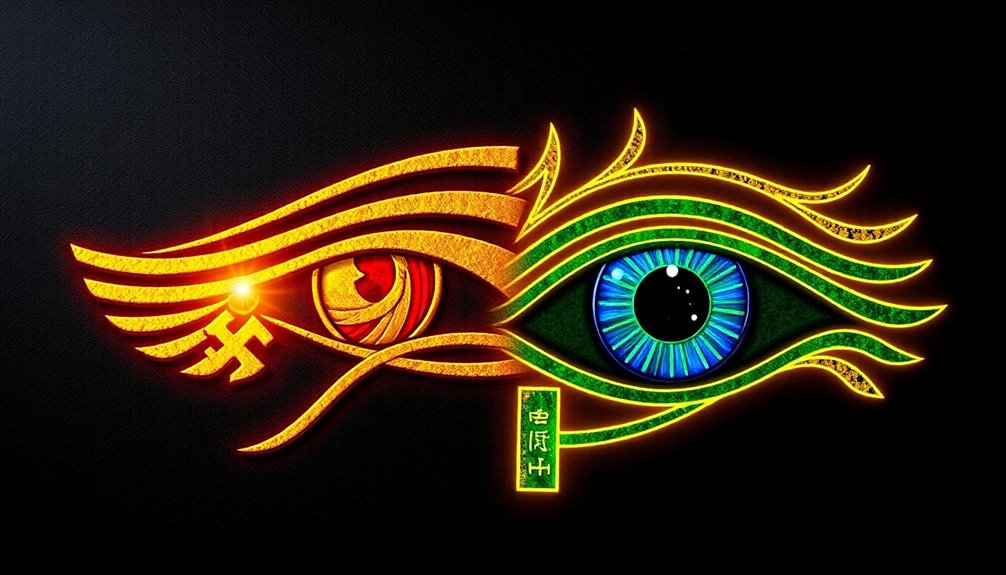
You can't ignore how the Eye of Ra and Eye of Horus have taken the fashion world by storm, showing up in everything from jewelry to tattoos.
Their symbolism resonates in modern art and wellness trends, making them more than just ancient icons.
Plus, social media plays a huge role in spreading their popularity, inspiring you to incorporate these powerful symbols into your own style.
Fashion and Accessories Trend
Embracing the Eye of Ra and Eye of Horus in contemporary fashion has become a powerful trend, with these ancient symbols finding their way into jewelry, clothing, and accessories.
Celebrities like Kim Kardashian and Gigi Hadid have showcased these motifs, increasing their appeal and sparking curiosity among fans. Designers are creatively integrating the Eye of Ra and Eye of Horus into their collections, utilizing luxurious materials to captivate modern audiences.
Here are four standout fashion pieces featuring these ancient Egyptian symbols:
- Gold Necklaces: Delicate chains adorned with the Eye of Horus pendant, perfect for layering.
- Statement Rings: Bold rings featuring intricate designs of the Eye of Ra, making a significant fashion statement.
- Embroidered Jackets: Trendy outerwear showcasing the symbols, adding an edgy twist to casual outfits.
- Colorful Bracelets: Vibrant gemstone bracelets incorporating both symbols, capturing attention wherever you go.
The resurgence of these symbols reflects a broader fascination with ancient Egyptian culture, blending historical significance with modern aesthetics.
Symbolism in Modern Art
Contemporary art often intertwines ancient symbols with modern themes, and the Eye of Ra and Eye of Horus are no exception. These powerful symbols have gained traction in the art world, representing protection, power, and duality.
Artists frequently incorporate them to evoke ancient wisdom and spirituality, tapping into the allure of Egyptian mythology within modern aesthetics.
The Eye of Horus, symbolizing healing and protection, contrasts with the Eye of Ra, which embodies strength and authority. This distinction allows you to investigate complex narratives through these iconic images.
In fact, many contemporary artists reinterpret these ancient symbols to probe into cultural identity and heritage, bridging the gap between past and present.
This resurgence of interest highlights not just the beauty of these symbols but their historical significance as well.
As you see the Eye of Ra and Eye of Horus in various artistic expressions, from paintings to installations, you'll recognize how they resonate with themes of empowerment and identity.
Their integration into modern art reflects a growing appreciation for the depth and richness of ancient Egyptian culture, making them relevant in today's creative landscape.
Social Media Influence
Harnessing the power of social media, the Eye of Ra and Eye of Horus have become symbols of strength and protection in contemporary culture.
You've likely seen these ancient Egyptian motifs pop up everywhere, from fashion to home decor. Influencers and celebrities are proudly showcasing these symbols, celebrating their protective qualities and cultural significance.
Here are some ways these symbols have captured attention:
- Jewelry and Tattoos: Stunning pieces featuring the Eye of Ra and Eye of Horus are trending, often displayed in beautiful designs.
- DIY Projects: Online tutorials for crafting evil eye jewelry have surged, allowing you to create personalized protective pieces.
- Fashion Brands: Collections incorporating these symbols reflect a growing fascination with ancient Egyptian aesthetics, blending history with modern style.
- Viral Hashtags: On platforms like Instagram and TikTok, hashtags related to the Eye of Ra and Eye of Horus have amassed millions of views, showcasing user-generated content that highlights their meanings.
Moreover, these symbols also resonate with the concept of cultural significance, which is often reflected in various forms of art and design across different cultures.
As you engage with this trend, remember the importance of understanding and respecting the historical context behind these powerful symbols.
The Future of Eye Symbolism
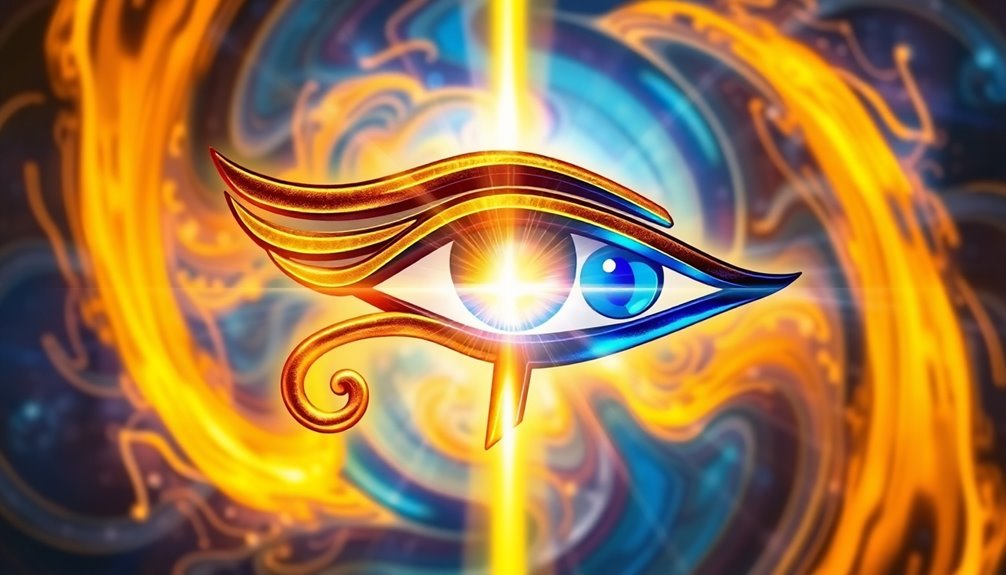
As you explore the future of eye symbolism, you'll notice how these ancient motifs continue to shape contemporary culture through fashion and art.
With evolving trends, the Eye of Ra and Eye of Horus aren't just relics; they're becoming symbols of identity and heritage.
It's crucial to reflect on how we can preserve their rich narratives while adapting them to modern expressions.
Symbolism in Contemporary Culture
Drawing inspiration from ancient Egyptian mythology, the Eye of Ra and Eye of Horus have found their way into modern culture, symbolizing protection, power, and spirituality.
You might notice these potent symbols popping up in various forms, often embraced by younger audiences seeking deeper meanings in their lives. Here are some ways they manifest in contemporary culture:
- Jewelry: Stunning necklaces and bracelets featuring intricate designs of the Eye of Ra and Eye of Horus, perfect for showcasing your unique style.
- Tattoos: Bold ink on skin, representing strength, healing, or a connection to ancient wisdom.
- Artwork: Modern pieces that reinterpret these symbols, blending ancient beliefs with contemporary aesthetics.
- Social Media: Influencers and artists sharing their stories, making these symbols trendy and accessible to a wider audience.
The Eye of Horus often reflects wellness and healing, while the Eye of Ra embodies strength and authority. Additionally, these symbols resonate with the desire for deep emotional connections, as they are often used in various forms of creative expression.
This enduring appeal highlights a cultural fascination with ancient beliefs, as these symbols are reimagined to align with modern values of empowerment and protection.
Evolving Fashion Trends
Embracing ancient symbolism, the Eye of Ra and Eye of Horus are shaping the future of fashion in exciting ways. Designers are increasingly incorporating these powerful symbols into their collections, blending protective qualities with contemporary style.
The Eye of Horus often appears in bohemian and spiritual-themed lines, attracting those who appreciate its associations with healing and protection. On the other hand, the Eye of Ra, symbolizing power and authority, is featured in bold statement pieces that resonate with individuals wanting to project strength and confidence through their fashion choices.
Social media platforms like Instagram and TikTok have amplified these trends, creating vibrant communities where enthusiasts share styling tips and explore the cultural significance of these symbols.
Moreover, fashion brands are becoming more conscious of their impact on cultural heritage. This awareness drives discussions around ethical sourcing and representation, ensuring that the incorporation of the Eye of Ra and Eye of Horus respects their origins.
As these ancient symbols evolve in the fashion world, they continue to inspire a blend of tradition and modernity, encouraging a deeper appreciation for their meaning and impact.
Cultural Heritage Preservation
The Eye of Ra and Eye of Horus carry profound cultural significance that transcends time, making their preservation imperative in today's society.
As these symbols gain popularity, it's essential to honor their origins and guarantee they're represented responsibly.
Here's what you can do to support cultural heritage preservation:
- Educate Yourself: Immerse yourself in the rich history of ancient Egyptian culture to understand the dual meanings of each symbol.
- Promote Awareness: Share your knowledge with others to foster a deeper appreciation of the Eye of Ra and Eye of Horus.
- Support Ethical Brands: Choose fashion and design companies that respect and represent these symbols authentically, avoiding misappropriation.
- Engage with Scholars: Follow organizations and researchers who advocate for responsible representations of these symbols, making sure they're celebrated correctly.
As global interest in ancient symbolism grows, you play an essential role in preserving the cultural heritage associated with the Eye of Ra and Eye of Horus.
Frequently Asked Questions
Which Is Better, the Eye of Ra or the Eye of Horus?
Choosing between the Eye of Ra and the Eye of Horus really depends on what you value more.
If you prioritize healing, protection, and resilience, you might find the Eye of Horus resonates with you.
On the other hand, if you lean towards power, authority, and a more aggressive energy, the Eye of Ra could be your pick.
Ultimately, it's about aligning with the symbol that reflects your personal beliefs and intentions.
What Does the Bible Say About the Eye of Horus?
The Bible doesn't mention the Eye of Horus, but its themes resonate with biblical concepts.
You'll find parallels in verses about God's protective nature, like Psalm 121:8, which assures you that God watches over you.
The Eye of Horus symbolizes healing and wholeness, echoing Isaiah 53:5's message of restoration.
While not a biblical symbol, its associations with protection and balance can enhance your understanding of divine safeguarding in scripture.
What Does 𓂀 Mean?
The symbol 𓂀, known as the Eye of Horus, represents protection, healing, and restoration.
When you encounter it, think of its connection to Horus avenging Osiris.
You'll see it depicted as a left eye with falcon-like features, linked to the moon.
This powerful symbol was used in amulets to guarantee safety and well-being, reflecting its importance in ancient Egyptian culture and daily life, symbolizing wholeness and completeness.
Is the Eye of Ra Bad?
You might see the Eye of Ra as bad due to its associations with vengeance and destruction.
It symbolizes punishment for those who defy divine authority, and its fierce nature can instill fear.
However, it also plays a vital role in maintaining cosmic order.
While it embodies wrath, it's not purely malevolent; it's a complex symbol reflecting the duality of ancient beliefs, balancing both protective and destructive forces.
Conclusion
As you explore the rich symbolism of the Eye of Ra and the Eye of Horus, you realize their stories are far from over. These ancient icons pulse with life, weaving through history and modern culture alike. But what's next for these powerful symbols? Will they evolve again, or reveal hidden meanings you haven't yet uncovered? As you investigate deeper, you might just find that the eyes are watching, guiding you toward a mysterious future.

